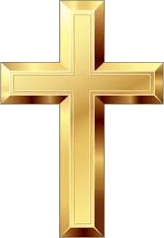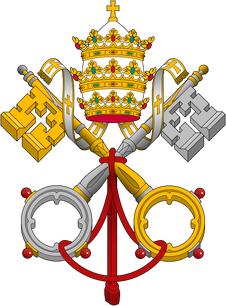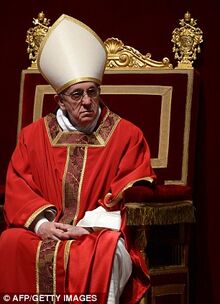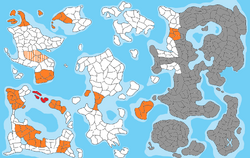| Selucian Patriarchal Church Ecclesia Patriarchalis Seluciana | |
|---|---|
 | |
| Abbreviation | SPC |
| Type | Hosian |
| Theistic philosophy | Monotheistic, Binitarian |
| Supreme divinity | Elyon |
| Major Pantheon | Auroria Grand Cathedral |
| Minor Pantheon | Triarium Grand Cathedral |
| Holy City | Auroria |
| Scripture | Hosian Bible |
| Governance | Episcopal |
| Arch-Patriarch | Augustus II |
| Last Scriba of the Convocation for the Doctrine | vacant |
| Headquarters | Auroria Grand Cathedral, Auroria, Selucia |
| Founded |
533 (Holy Apostolic Hosian Church of Terra 2385 (modern SPC) |
| Branched from | Holy Apostolic Hosian Church of Terra |
| Merged into | Aurorian Patriarchal Church |
| Defunct | 3876 |
| Liturgical language | Selucian language |
| Liturgical rite | Selucian (Latin) Rite |
| Members | 670 million |
| Other name(s) | Holy Apostolic Hosian Church of Terra (officially), Selucian Church |
The Selucian Patriarchal Church (Selucian: Ecclesia Patriarchalis Seluciana) was a major Hosian church that existed between the 24th century and the 39th century.
Following the Second Council of Auroria, the Church entered full communion with the Theognosian Church and became known as the Aurorian Patriarchal Church. Throughout its history the Church was led by the Arch-Patriarch, who is considered to have been succeeded by the Arch-Patriarch of the Aurorian Patriarchal Church.
Name[]
The term Selucian Patriarchal Church was rarely used by the Church itself, as it saw itself as the true successor to the Holy Apostolic Church of Terra and therefore the true Ecumenical Church referenced in the Aurorian Creed. This doctrinal position, which derives from the primacy of St. Michael Vigilius and apostolic succession from St. Michael to the Bishop of Auroria, has been upheld despite the pronouncements of Arch-Patriarch Justus III in his Apostolic Constitution In Caelo Ecclesia, which declared that despite the Church's pure historical continuity with the Holy Apostolic Church, other churches with valid revelations and apostolic successions were existing in a state of schism rather than heresy.
History[]
The Selucian city of Auroria was the head of the Holy Apostolic Hosian Church of Terra, created in 533 after the Council of Auroria, and the Arch-Patriarch of the Holy Apostolic Church was recognized as the leader of Western Patriarchal Hosianism. In time the Arch-Patriarchy gained secular control of the city of Auroria and its possessions, becoming the largest and most powerful political faction on the Selucian Archipelago during the Middle Ages. During the Renascentia the Arch-Patriarchy became one of the major sponsors of cultural and artistic revival, partly in reaction to the reemergence of Paganism.
The Unification of Selucia, accomplished under Pagan Nationalist leadership, was opposed by the Arch-Patriarchy, so that after the fall of Auroria in 1811 the Great Persecution of Hosians in Selucia was imposed by the government of new nation. Selucian Hosians, forced underground, continued Hosian worship in secret, but the persecutions led to a Dark Age in the Church, putting an end to the Arch-Patriarchy in 1819. The other branches of the Holy Apostolic Church, having lost contact with Auroria and believing Apostolic Succession to have ended in Selucia, consequently became independent, effectively abolishing the Holy Apostolic Hosian Church of Terra. Selucian Patriarchals however claim that the Arch-Patriarchy was only in a state of sede vacante, and to this day regard their church as the true successor of the Apostolic Church, a fact expressed in the fact that alone of all the major Patriarchal Churches, the Selucian Arch-Patriarchs are still numbered from the days of the early church, while the others are typically numbered from the revival of the Terran Arch-Patriarchy in Deltaria onwards.

The Tiara, symbol of the Arch-Patriarch
As the persecution of Hosians eased in Selucia, and the influence of Hosianism in Selucia grew once more, in 2385 the Selucian Church elected Ioannes I as the first Arch-Patriarch in Auroria after centuries of persecution, claiming direct continuity with the old Holy Apostolic Hosian Church of Terra. The newly elected Arch-Patriarch in Auroria attracted support from a diaspora of adherents of the now-defunct Apostolic Church across the world, reinstituting bishoprics in certain places. A massive influx of the faithful did not emerge until much later, but since then the Church steadily grew. The point of inflexion in the Church's membership is found as the Deltarian Arch-Patriarchate continued to digress from the position of the old church, prompting the clergy of several provinces to enter communion with the reborn Aurorian Arch-Patriarchy. As the trouble in the Terran Patriarchal Church continued, the Selucian Patriarchal Church grew as a conservative alternative: eventually, the Theognosian Church emerged as a more progressive counterpart.
For centuries the Church, based in the City of the Empyrean Temple, a city state within Auroria, was the largest Hosian denomination on Terra. Still regarding itself as the true successor of the Apostolic Church, the Church eventually (especially under Arch-Patriarch Justus III) moderated this claim in favour of dialogue with what the Church perceived to be the only non-heretical Patriarchal denomination, the Theognosian Church.
The Church experienced a schism in 3294, when Baldovino Cardinal Gioia, Metropolitan Arch-Episkope of Luthor, declared himself pope and took control of the Church in Luthori. One of his first actions was to excommunicate the Church leadership in Pontesi, which had been occupied by Selucian and Barmenian forces. Some believe this act to have caused by political motives, as Luthori was an ally of Pontesi through the International Monarchist League. The splinter sect has since then gone extinct, and Arch-Patriarch Justus III, in his motu proprio Rex Aeternus has ended the implict teaching in the Church against monarchism (and democracy) that briefly ensued because of the crisis.
Between 3797 and 3876 the Second Council of Auroria took place, an attempt to reunite the three Western Patriarchal Churches that derived their legitimacy from the Holy Apostolic Hosian Church of Terra, namely the Selucian Patriarchal Church, the Terran Patriarchal Church, and the Theognosian Church. The Terran Patriarchal Church ultimately withdrew from the Council due to irreconcilable differences, but the Selucian and Theognosian delegations continued the Council, and in 3876 the Second Council of Auroria concluded with the reunification of the Selucian Patriarchal Church and the Theognosian Church, forming the Aurorian Patriarchal Church.
Organization[]

The Church was led by the Bishop of Auroria, who held the titles of Arch-Patriarch and Supreme Watcher of the Selucian Patriarchal Church as the successor of St. Michael Vigilius. The Arch-Patriarch was considered infallible and had absolute control over the organisation, though in practice this control iswasmoderated by the Aurorian Convocationes, appointed by the Arch-Patriarch, which managed many of the day-to-day activities of the Church. The Arch-Patriarch was elected by the College of Cardinals in a procedure known as an Arch-Patriarchal Conclave. Following the promulgation of the Apostolic Constitution Pastor Omnium Piorum by Justus III, a Conclave had to be called at least a month following the occurrence of a vacancy in the Arch-Patriarchy, and a so-called dark age in which a continuous vacancy occured could only be declared if the Conclave could not elect a successor with the required two-thirds support. Previously, the requirement of a unanimous vote made it extremely difficult to elect an Arch-Patriarch, leading to frequent dark ages in the modern period.
Beliefs[]
"We love, revere, and worship Eliyahu, who is our saviour. We know that he is equal to Elyon, as they both compromise Godhood. We were gifted by the wisdom to understand this mysterium by sacred tradition. All who deny this, we declare to be anathema, to be renegades and destined for the pits of hell, if they do not repent.
We are the Church Millitant, the fighting Church, the salt of this world, waiting for our Lord and Saviour to return and liberate us. We are led in our faith by the saints, our paragons and friends, who are in heaven, giving their never-ending intercessions for us to our Lord. Like him, they are worthy of our worship and reverence. The foremost of them are His mother, Sarahea, who is the Empress of Heaven, and is a pure and untainted being, one fully without sin.
We know that there is no Hosianism as pure and good as the Selucian Patriarchism, that all other denominations are in heresy, that their flock has been led astray from the one and only way to Paradise. All this we know from tradition, and from our two most sacred scriptures. The Katub, which is the Word of Elyon, and The Annunciation, which is the Word of Eliyahu. Both of these sacred texts are infallible, though should not be read in any way except as interpreted by the authority by the Selucian Church. This we consider of the uttermost importance. Disrespect for the rightful authorities is always a direct way to hell."
- Excerpts from Ansgar Cardinal Þorirsson, Metropolitan Archeparch of Lerna, stating the basic tenets of the Selucian Faith
The Aurorian Creed[]
"We believe in one God, Almighty Father to Us All, Who created Terra and Caelum, all that is visible and invisible, (Who led Ehud to Holy Yishelem, and shielded his people.)
And we believe in one Lord, Eliyahu Hosios, Pure and Holy Spirit of God, Created with Terra before all ages, Announced through prophesy, Holy Word of God, through the virgin Sarahea in man incarnate, Who is light to our world, True servant of the one true God,
Who called us, the Pious, to follow His word, And was exiled to the desert by vengeful man, Who, persecuted even in exile, Strengthened His resolve, and did His duty, Even in the face of death. For forty days did He pray in His despair, And then ascended into heaven. And on the third day He did descend to hell to bear our sins. Returned triumphant, then disappeared into Hiding, According to scripture.
Who, with divine Grace, Sent to us the Light of God, Which illuminated His Word to the prophets of old, To remain with us to light the way, And give us strength to believe, In memory of those who came before,
We believe that he has life eternal, And that at the end of times, He shall return to judge living and dead, To be Saviour of Terra, And that His Kingdom shall continue, In time and eternity.
Until such a time, we hold true to His teachings, Hear and live His Annunciation, In the Community of the Pious, One holy, apostolic and ecumenical Church, We acknowledge one Sacrifice of Water for the remission of sins, In the hope that we shall live again, In life eternal.
Amen."
- Formalized by the Fathers of the Council of Auroria, 533
Sacrifices (Sacraments) of the Selucian Church[]
The Holy Sacrifices of the Hosian Church were the centerpiece of the faith, although not all Sacrifices were accepted in all churches. Although derived from the word in its original meaning, "Sacrifice" is, theologically, distinct from "sacrifice" (as in the offering of goods to God), and is translated differently into different languages (Sacrificie instead of Opfer in Dovichan, Sacrificie instead of offer in Kazulian, et cetera). In Selucian Patriarchal Hosianism, there were seven Sacrifices from cradle to grave:
- Sacrifice of Water (Baptism)
- Sacrifice of Gratitude (Revelation, equivalent of the Eucharist)
- Sacrifice of Fire (Illumination, similar to confirmation)
- Sacrifice of Piety (Vocation, consecration of priests)
- Sacrifice of Love (Marriage)
- Sacrifice of Purity (Remission, similar to confession)
- Sacrifice of Memory (Burial)
Social teachings[]
"We declare, that the matters of politics and theology are twinned, but of different natures, and should remain separated from each other. The Church believes that this is a sound order, but insists that the Ehudio-Hosian values that constitutes the foundations of all humanism and the Natural Rights, cannot remain separated from political matters. We therefore oppose the idea of religious parties.
Furthermore, we cannot condone abortion, as we see it as a violation of the basic human right and duty of life. So is also euthanasia. We oppose and condemn these actions as crimes, though we ask or respect and forgiveness for those guilty of these sins.
Sexual relations should, in our view, be reserved for the sanctuary of the Sacrifice of Love. Adultery is harmful to society and the individual, and is a grave mistake and a sin in our eyes, as it harms the individuals involved, as well as all kindered and society as a whole. We also condemn contraception as it makes a promiscuous lifestyle possible for a longer time.
In line with our views on sexual purity, we also oppose homosexuality as something that goes against the natural law. For us it is obvious that the reproductive phenomena were made for procreation, and cannot be condoned in a sterile relationship. Marriage is and shall ever remain, no matter if agreed on without the Sacrifice of Love, the societal definition of the foundation of a family, which consists of a man and a woman and their children. The definition should be used to benefit those who form families.
As part of our opposition to radicalist experiments, we support the market economy, supplemented with adequate ethical responsibility, and declare that solidarity can be prevented by socialization. Society is separate from the state, and should not be subject to any social experiments by the government. The leaders of the state has a responsibility to protect the natural rights of their citizens, but also to defend their nation's culture and society's freedom.
Beacuse of this, we declare that radical egalitarianism is inherently evil, as God gave each man different traits that placed us on different levels of society. We believe that all individuals are equal in the sense that all are born with the same fundamental rights of life, property and tolerability, but not in the sense that all are to be forced into societal equality. We condemn such views as utopian and un-hosian. We also declare civil disobedience a grave evil, as the law is a righteous thing by itself, and a society where everyone follows their own laws will quickly descend into anarchy. The faithful should work inside the law to fight injustice and unethical phenomenas, and not against it. We also call for a sound and balanced view of the concerns of environmental protection, as we do not wish the faithful to be deceived by great economic interests in the name of environmental hysteria."
- Cardinal Verner Ljungborg, Archeparch of Barmenia, on the Social teachings of the Selucian Church
Provinces[]

Provinces of the Selucian Patriarchal Church in 3392. Orange denotes a province, while red denotes a country where Selucian Patriarchalism iwas the state religion. Note that the province of Luthori only existed de jure, because of the recent schism.
| Province Name | Divisions | Seat | Leading persons, notes, misc. |
|---|---|---|---|
| Province of Selucia | Archdiocese of Auroria, Diocese of Victoria, Diocese of Kabbasa, Diocese of Augusta, Diocese of Goldaria | Archdiocese of Auroria | |
| Province of Jelbania | Primate of Jelbania, Episkope of Pittsway Cove, Episkope of Surel, Episkope of Wattrelies, Episkope of Coruscant | Primate of Jelbania | |
| Province of Luthori | Archdiocese of Oalapo, Diocese of Geharon, Diocese of Yodukan, Diocese of Tinako, Diocese of Orange, Diocese of Utagia | Archdiocese of Oalapo | Luthori is a de jure province due to a schism with the church. |
| Province of Malivia | Archdiocese of Syrene, Diocese of Dendars, Diocese of Itaki, Diocese of Polkana, Diocese of Walkunia, Diocese of Washibar | Archdiocese of Syrene | |
| Province of Aldegaria | Archdiocese of Aldegaria, Diocese of Amuro, Diocese of Hilkirena, Diocese of Kemoku, Diocese of Polran, Diocese of Somasi | Archdiocese of Aldegaria | |
| Province of Beiteynu | Archdiocese of Yishelem, Diocese of Endild, Diocese of Fruskilla, Diocese of Padrika, Diocese of Quo'gun, Diocese of Tadraki | Archdiocese of Yishelem | |
| Province of Dorvik | Archdiocese of Haldor, Diocese of Mothar, Diocese of Miktar, Diocese of Kordusia, Diocese of Dorvan, Diocese of Largonia | Archdiocese of Haldor | Archbishop Eckart Haase (appointed March 11th, 3390) |
| Province of Indrala (Patriarchate of Dovani, Patriarchate of the East) | Bishopric of Beizhou, Bishopric of Nanzhou, Bishopric of Dengzhou, Bishopric of Dongzhou | Bishopric of Beizhou | |
| Province of Hulstria and Gao-Soto (Patriarchate of Dovani, Patriarchate of the East) | Primacy of Hulstria and Gao-Soto, Metropolitan Archbishopric of Phonix, Bishopric of Marbruck, Bishopric of New Liore, Bishopric of Marchau, Bishopric of Korriel | Primacy of Hulstria and Gao-Soto, Metropolitan Archbishopric of Phonix | Matthias Lemann, Archbishop of Phönix |
| Province of Dranland (Patriarchate of Dovani) | Primacy of Dranland, Metropolitan Archbishopric of Iglesia Mayor, Bishopric of Comares-Gongmangdo, Bishopric of Llwybr Hawl, Bishopric of Gogledd Pwynt | Primacy of Dranland, Metropolitan Archbishopric of Iglesia Mayor | |
| Province of Pontesi (Patriachate of the Pontesi Rite, Pontesi (Eastern) Rite) | Primacy of Pontesi, Metropolitan Archeparchy of Lerna, Eparchy of Diar Elahmar, Eparchy of Dawnstar, Eparchy of Nazirija, Eparchy of Anastaiah | Primacy of Pontesi, Metropolitan Archeparchy of Lerna | |
| Archepachy of Barmenia (Pontesi (Eastern) Rite) | Primacy of Barmenia, Metropolitan Archeparchy of Sekhmet, Eparchy of Maneko Neki, Eparchy of Demeter, Eparchy of Dinah,Eparchy of Meowth | Primacy of Barmenia, Metropolitan Archeparchy of Sekhmet | |
| Patriarchy of the West Cildanian Rite (West Cildanian Rite (Antiochian)) | Primacy of Cildania, Metropolitan Archeparchy of Cildania City, Eparchy of Velieres, Eparchy of Santa Alexandra, Eparchy of Qart Yam, Eparchy of Qart Ramesh | Primacy of Cildania, Metropolitan Archeparchy of Cildania City | |
| Patriarchy of Kalistan (particular Kalistani Patriarchal Church) | Patriarchy of Kalistan | As a particular autocephalous church, the Kalistani Patriarchal Church acknowledged the main teachings of the SPC and the primacy of the See of St. Michael, but maintained some doctrinal and liturgical distinctiveness. | |
| Patriarchy of Keymon (particular Church of Keymon) | Patriarchy of Keymon | As a particular autocephalous church, the Church of Keymon acknowledged the main teachings of the SPC and the primacy of the See of St. Michael, but was granted some organisational autonomy, including the autonomy to elect its own Patriarch. |
